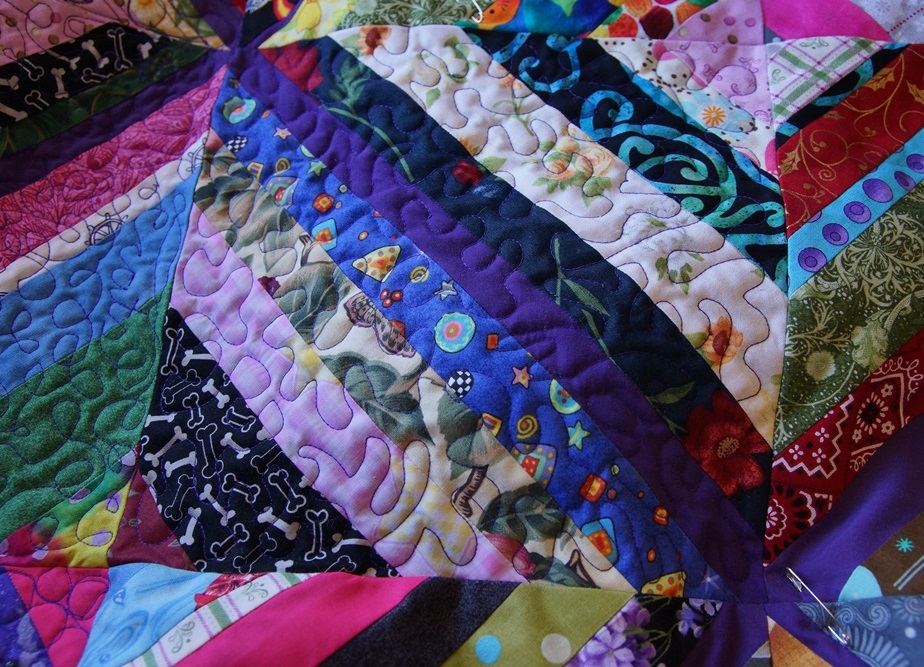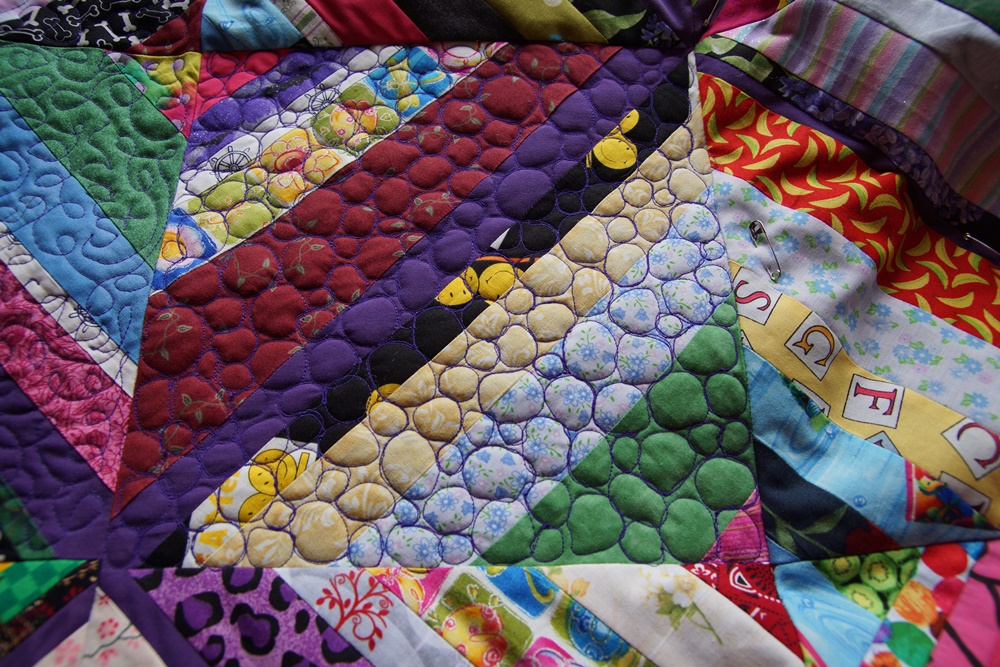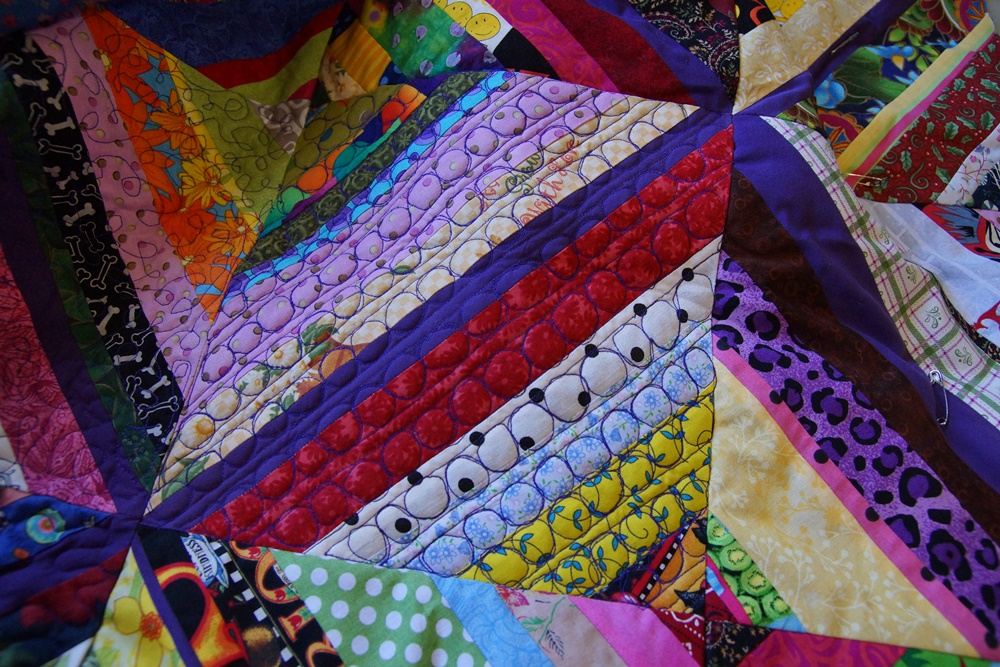More experimentation
This is the second time I’ve written this post. This morning I wrote a long (and, of course, incredibly witty and entertaining) version of it, but when I hit publish WordPress just laughed at me and ate it. And I didn’t have time to re-write it straight away, because I had to run off and catch a bus. So this will be a much briefer and nowhere as good version. As you read it, just imagine you’re actually reading the much better original. You would have enjoyed it…
Anyway, having read all of the projects in Free Motion Quilting for Beginners and wanting to try all the things, I decided I’d do just that – I’m going to work my way through each of the patterns in the book, and quilt a square in each (the actual projects in the book are for simple little objects to create using quilting, the idea being that you can practice on them rather than diving straight into a full sized quilt. But you know me, why start with something simple when the deep end looks so much more fun?). And anyway, this quilt is all about being experimental and trying new things, so what better than to turn it into a library of patterns (ok, a library of attempts at the patterns – based on experience so far, some will be more successful than others).
So, first up is a combination of “loop de loop” and “handwriting”. Hanson suggests starting with handwriting because you’re already familiar with the movements involved. Yeah, except I’m terrible at writing in proper joined-up script (which of course you have to do when you’re “writing” with a sewing machine – you can’t exactly lift the pen off the paper between letters) – my natural writing style is a very not-joined-up printing. But I gave it a go, and it didn’t come out any worse than my writing on paper does 🙂

I bet you can’t guess what word I chose to incorporate into my quilt 😉

The next pattern was “stippling”. Of course, I’ve already tried this one out on a couple of other projects, but I decided to include it anyway, for completeness (and because I definitely still need a lot of practice at it – my stipples keep getting confused and turning into loops). It turned out to be a lot trickier on a big quilt, with all that fabric to move around, not just a little cushion cover.

Then “pebbles”. This pattern was fun, and had the bonus effect of forcing me to slow down, because you have to retrace your steps quite often. My quilting definitely improves when I slow down, but I’ve noticed a tendency that the more I’m having to concentrate, the harder my foot goes down on the pedal (I think because I’m tensing up), so I start speeding up just when I should be slowing down (this is why it’s a very good thing that I don’t drive!). It uses a HUGE amount of cotton, though – I think I went through an entire bobbin’s worth on this square alone.

But I love the 3D effect it produces.

Finally, “chain of pearls”. Similar to pebbles, but for me it was a total fail – I just couldn’t manage to keep the spacing and size consistent. In retrospect, I probably shouldn’t have sewn them in the same direction as the stripes of fabric – they were too distracting. Oh well, the overall effect looks ok from a distance… if you squint your eyes a bit… and hold your head on just the right angle…

Things I have learnt so far:
- Quilting on this scale is very different to the little mats and cushions I’ve been doing so far. Moving all that fabric around is hard work! (And this isn’t even a big quilt – I can’t imagine how hard it would be to work on something big enough for a bed!) I’m starting to understand why all the blogs recommend using grippy quilting gloves and a super-slidey mat thing between machine and fabric.
- I am much better at random freehand designs than anything that requires structure and consistency (big surprise there – not).
- I’m going to have to buy a lot more cotton before I get this quilt finished – quilting (especially the denser patterns) just eats it up.
- Google knows everything, including exactly where to oil your 30-something year old sewing machine to stop it squeaking through overuse. I even found a maintenance diagram for exactly this model.
- If you leave an unfinished quilt alone for more than 10 seconds, it becomes a cat magnet. Said cat gets very angry when you try and move her off her comfy new bed just because you’d like to keep the quilt at least slightly free of cat fur – just until it’s finished, anyway.

For some reason I have stopped getting notifies from you! This is unacceptable! 🙂
Can you make sure the right boxes are checked on your end and I’ll check mine.
Love your free motion experiments!!!
Weird – I wonder if it’s related to the hacking on the old site that Steve was talking about? I’ve still been getting notifies from you, as far as I can tell.
Anyway, I checked, and all the boxes are ticked, so hopefully if the same as true at your end it will work now.